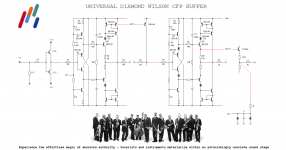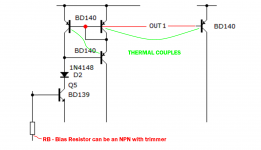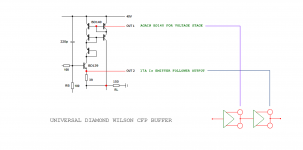Hi jes, useful information there.
Have you tried to Soundlab approach in their A1's of using two transformers, one optimised for bass and the other for mid/high? Its an approach I have been promising myself I would try out on my rebuild, which will be a segmented design so I can feed each segment from a separate transformer.
Have you tried to Soundlab approach in their A1's of using two transformers, one optimised for bass and the other for mid/high? Its an approach I have been promising myself I would try out on my rebuild, which will be a segmented design so I can feed each segment from a separate transformer.
Hi Susan,
Really impressed with your good effort.
Have you ever tried a split bifilar winding method? Due to reduced capacitance between sections with strong bifilar coupling within section, it may deliver an improved response in your push pull circuit compared to the published quadfilar method.
To further increase performance, you may also consider winding each section in opposing direction with a ground shield between sections. Connecting the outer end wires of the winding to the sources of the mosfets and the inner end wires of the winding to ground at the input side would also reduce large signal distortion.
A 1:1 output connected to outer end wires winding with inner end wires connected together theoretically gives best frequency response. But since a 2:1 connection measures better on your previous builds, it is very hard to tell which will give better overall.
Indrawan
Really impressed with your good effort.
Have you ever tried a split bifilar winding method? Due to reduced capacitance between sections with strong bifilar coupling within section, it may deliver an improved response in your push pull circuit compared to the published quadfilar method.
To further increase performance, you may also consider winding each section in opposing direction with a ground shield between sections. Connecting the outer end wires of the winding to the sources of the mosfets and the inner end wires of the winding to ground at the input side would also reduce large signal distortion.
A 1:1 output connected to outer end wires winding with inner end wires connected together theoretically gives best frequency response. But since a 2:1 connection measures better on your previous builds, it is very hard to tell which will give better overall.
Indrawan
PP Line Driver/SE Line Driver
Susan,
Do you prefer the PP line driver or the SE line driver?
Does Sowter make the XFM for the SE driver stage?.
Look's like the Sowter 9940 is for the PP line driver.
I plan on using the 1035 Attenuator.
Another simplistic question: What kind of material would you use to make the transformers
smaller and lighter? (Amorphous Double C Core)?
Sam
Susan,
Do you prefer the PP line driver or the SE line driver?
Does Sowter make the XFM for the SE driver stage?.
Look's like the Sowter 9940 is for the PP line driver.
I plan on using the 1035 Attenuator.
Another simplistic question: What kind of material would you use to make the transformers
smaller and lighter? (Amorphous Double C Core)?
Sam
Another simplistic question: What kind of material would you use to make the transformers smaller and lighter?
Simplistic but not simple - keeping DC out of the cores (ie use PP not SE) is about the only universally agreed way to keep core sizes down.
I'd go further and ask: why?
There are other ways of achieving 80% of the performance at much less cost (see Parker's early postings here and on her site or search for "poor man's raven") with the same architecture.
And fans of conventional amplifiers will claim you get better performance with without transformers for a lot less money
So again - why are you trying to save weight?
Thanks to Susan and all contributors to this lovely thread.
I long to hear this amp. I'm 80 minute drive NE of Salt Lake City, Utah, "Mile Marker 6" south of the Idaho border on Utah Highway 89.
It would be exceptionally kind and generous if a US resident posted here an offer for brief audition.
What is estimated total parts cost?
I long to hear this amp. I'm 80 minute drive NE of Salt Lake City, Utah, "Mile Marker 6" south of the Idaho border on Utah Highway 89.
It would be exceptionally kind and generous if a US resident posted here an offer for brief audition.
What is estimated total parts cost?
Member
Joined 2009
Paid Member
I am having trouble posting, something has gone wrong with my profile being merged with another's.
i reported your problem, help is on the way,
I am having trouble posting, something has gone wrong with my profile being merged with another's.
Check and see whether your bank balances have merged. It might be profitable, to your benefit.
This is what I was trying to post...
Sorry for the recent silence.
My father was taken ill in April, and a short visit to hospital became a month's stay as his condition worsened.
He passed away at the hospital here in London on Sunday 25th May.
His funeral was on Wednesday 11th June.
Best wishes to everyone,
Susan.
P.S.
Don't forget an amorphous core will have a lower saturation point than M6 GOSS for an equivalent cross section, so an amorphous transformer will have to be bigger for the same power saturation curves.
The benefit of an amorphous core is in the Eddy currents, which will be improved (i.e. reduced) by the use of an amorphous core.
I intend to do an A/B comparison at some point (yes, honest), as there are other factors affecting performance; for example the driving impedance and turns ratios.
Sorry for the recent silence.
My father was taken ill in April, and a short visit to hospital became a month's stay as his condition worsened.
He passed away at the hospital here in London on Sunday 25th May.
His funeral was on Wednesday 11th June.
Best wishes to everyone,
Susan.
P.S.
Don't forget an amorphous core will have a lower saturation point than M6 GOSS for an equivalent cross section, so an amorphous transformer will have to be bigger for the same power saturation curves.
The benefit of an amorphous core is in the Eddy currents, which will be improved (i.e. reduced) by the use of an amorphous core.
I intend to do an A/B comparison at some point (yes, honest), as there are other factors affecting performance; for example the driving impedance and turns ratios.
Funding options...
If only
Check and see whether your bank balances have merged. It might be profitable, to your benefit.
If only
Profile issues
Many thanks. Appreciated.
i reported your problem, help is on the way,
Many thanks. Appreciated.
I am having trouble posting, something has gone wrong with my profile being merged with another's.
please try logging in as Susan_Parker and let us know...
Sorry for the recent silence.
My father was taken ill in April, and a short visit to hospital became a month's stay as his condition worsened.
He passed away at the hospital here in London on Sunday 25th May.
His funeral was on Wednesday 11th June.
Best wishes to everyone,
Susan.
Susan: very sorry to hear about your Dad. Best regards Moray James.
Recovered
My details etc. are recovered. Awesome
Many thanks.
Best wishes,
Susan.
please try logging in as Susan_Parker and let us know...
My details etc. are recovered. Awesome
Many thanks.
Best wishes,
Susan.
- Home
- Amplifiers
- Solid State
- Zero Feedback Impedance Amplifiers


